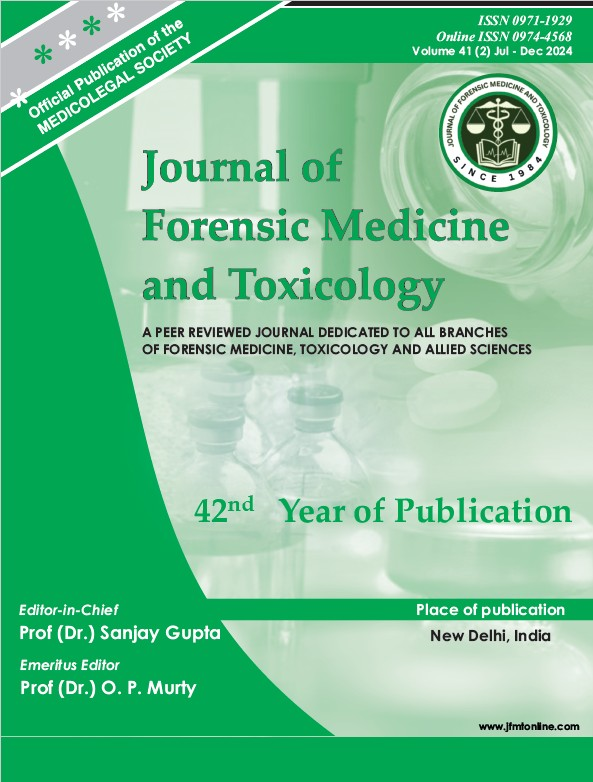DEVELOPMENT OF LATENT FINGERPRINTS USING CLITORIA TERNATEA AND CURCUMA LONGA POWDERS
Keywords:
Clitoria ternatea, Curcuma longa, Latent fingerprint, DevelopmentAbstract
Fingerprint powders have been used for decades as a robust technique for the developing latent fingerprints. However, inhaling traditional powers can pose health hazards for the person using it and those around them. This research aimed to develop a safer and cost-effective method for visualizing latent fingerprints on non-porous surfaces. The study used non-toxic plant-origin powders extracted from Clitoria ternatea and Curcuma longa. The powders were manufactured using a simple methodology and were evaluated for their effectiveness in developing fingerprints on different surfaces. The results showed that Clitoria ternatea powder can develop latent fingerprints on plastic, wooden laminate, glass, and steel surfaces, while Curcuma longa powder was effective on glass and laminate surfaces. The development process revealed clear ridge patterns that can be compared to known fingerprints for identification purposes. The use of natural sources reduces the toxicity of the powders, making them safer to use compared to traditional powders. This study presented promising results in developing latent fingerprints.
Downloads
References
Bhavana D, Ruchi J, Prakash T, JL K. Study of fingerprint patterns in relationship with blood group and gender-a statistical review. Arches. 2013;1(1):15-17.
Stimac JT. Plastic fingerprint impressions: An inked approach. Journal of Forensic Identification. 1998 Sep 1;48(5):574.
Sanjiv K, Sodhi GS, Kapoor S. A Multipurpose Composition Based on Brilliant Blue R for Developing Latent Fingerprints on Crime Scene Evidence. J Forensic Investigation. 2014;2(1):3.
Choi MJ, McBean KE, Ng PH, McDonagh AM, Maynard PJ, Lennard C, Roux C. An evaluation of nanostructured zinc oxide as a fluorescent powder for fingerprint detection. Journal of Materials Science. 2008 Jan;43:732-737
Sekar M, Zulkifli NF. Development of natural latent fingerprint powder from durian seeds-a green and effective approach in crime scene. Indo American Journal of Pharmaceutical Sciences. 2017 Aug 1;4(8):2362-2367.
Ramanan V, Nirmala M. Visualization of Latent Fingerprints using Neutral Alumina as an Inexpensive Fingerprint Developing Powder. Int. J. Forensic Sci.. 2020;3:5-10.
Baskaran A, Mudalib SK, Izirwan I. Optimization of aqueous extraction of blue dye from butterfly pea flower. InJournal of Physics: Conference Series 2019 Nov 1 (Vol. 1358, No. 1, p. 012001). IOP Publishing.
Garg RK, Kumari H, Kaur R. A new technique for visualization of latent fingerprints on various surfaces using powder from turmeric: a rhizomatous herbaceous plant (Curcuma longa). Egyptian Journal of Forensic Sciences. 2011 Mar 1;1(1):53-57.
Sivakumar V, Vijaeeswarri J, Anna JL. Effective natural dye extraction from different plant materials using ultrasound. Industrial Crops and Products. 2011 Jan 1;33(1):116-122.
Sinha K, Saha PD, Datta S. Extraction of natural dye from petals of Flame of forest (Butea monosperma) flower: Process optimization using response surface methodology (RSM). Dyes and Pigments. 2012 Aug 1;94(2):212-216.
Jothi D. Extraction of natural dyes from African marigold flower (Tagetes erecta L) for textile coloration. Autex Research Journal. 2008 Jun 2;8(2):49-53.
Putra SL. Recovery of fresh latent fingerprints on black clothing fabrics using Lumicyano™ (Doctoral dissertation, Murdoch University).
De Alcaraz-Fossoul J, Mestres Patris C, Balaciart Muntaner A, Barrot Feixat C, Gené Badia M. Determination of latent fingerprint degradation patterns—a real fieldwork study. International Journal of Legal Medicine. 2013 Jul;127:857-70.




